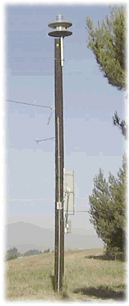|
Shelter-in-Place Preparation
What is "Shelter-in-Place"?
How do you know when to
Shelter-in-Place?
What should we do during a chemical
emergency?
How long will the sirens
sound?
How will we know when the emergency
is over?
When are the sirens tested?
How can I better promote
Shelter-in-Place safety in my place of work?
 What
is "Shelter-in-Place"? What
is "Shelter-in-Place"?
In the
event of a chemical release, safety sirens in
Sarnia’s
industrial corridor will sound to alert the public. If you hear the
sirens, or are told to Shelter-in-Place, emergency officials
recommend that you Shelter,
Shut and Listen:
-
Stay inside
-
Close all
windows and secure doors (locking provides a tighter seal).
-
Turn off all
ventilation systems such as heating or air conditioning.
-
If there are
gaps in windows or doors, seal with tape or damp towels.
-
Have an battery
operated radio for emergencies and tune to local radio stations for more
information
How do
you know when to Shelter-in-Place?
Sarnia
has a Community Warning System in
place that uses several tools to alert the public. If there is a
chemical release with the potential to impact the community, the
outdoor Safety Sirens located in the vicinity of the emergency will
be sounded. The sirens will sound for about 3 minutes, and will be
re-sounded periodically during the emergency. The sirens are tested
on Mondays at 12:30 p.m. Safety sirens are located in the downriver
industrial corridor and in the City of
Sarnia.
 Details
during a Shelter-in-Place incident are issued by emergency officials
via the news media.. Local radio stations will sound an alert tone
interrupting regular broadcasts, followed by a voice message about
the chemical emergency. Be sure you have a battery powered radio at
home and at your place of work. Details
during a Shelter-in-Place incident are issued by emergency officials
via the news media.. Local radio stations will sound an alert tone
interrupting regular broadcasts, followed by a voice message about
the chemical emergency. Be sure you have a battery powered radio at
home and at your place of work.
Top
What
should we do during a chemical emergency?
If
emergency officials recommend that people in your area
Shelter-in-Place, you should stay inside and encourage customers,
vendors, and others to do the same. Allow people from outside to
Shelter-in-Place in your home or workplace. Begin implementing your
site emergency plan. For a Shelter-in-Place emergency, you will need
to stay inside until the chemical leak has stopped and winds have
dissipated any vapors in the vicinity.
Here are the recommended steps to Shelter-in-Place:
1.
Advise everyone to stay inside.
Announce to everyone in the building that the City has issued a
Shelter-in-Place advisory. Recommend that people not leave the
building during this time unless specifically ordered to do so by
police or fire personnel. Leaving the building could result in
exposure to toxic chemical vapors.
2.
Close all doors, windows and other sources of outside air.
Close and lock windows for a tighter seal. Control access doors
(locking will provide a tighter seal). Post a “Shelter-in-Place in
Effect – Controlled Access” sign in the window so that people
outside will know you are closed and Sheltering-In-Place. If
additional people want to enter to Shelter-in-Place, minimize the
time the door is held open. Move others in the room away from the
door that is opened. People who insist on leaving the building
should be allowed to leave, but advise them it is at their own risk
since emergency officials have issued a Shelter-in-Place advisory.
3.
Turn off all air conditioning or heating systems
Your building’s thermostats or air-handling cutoff switches should
be labeled, and employees should be trained where they are located
and how they work. Ceiling fans or portable fans can be used inside
to keep cool while the ventilation system is shut down.
4.
Turn on your battery operated radio to a local radio station
Emergency officials in
Sarnia
recommend tuning to one of the local radio stations for emergency information. Officials
will be providing the news media with updated information on the
locations that should continue to Shelter-in-Place. If you have a
television available, Cogeco Cable will also provide news reports,
and should scroll information during the event.



5.
Stay off the telephone
Avoid using the phone so it is available to receive the
informational call. Do not call 9-1-1
to get more information. Only call
9-1-1
if you need immediate assistance with a life-threatening emergency.
Overloaded telephone circuits (including cellular phone calls) can
prevent actual emergency calls from getting through.
Top
How
long will the sirens sound?
The
sirens will sound initially for about three minutes. They will
continue to be resounded periodically if the event continues.
Shelter-in-Place alerts are also broadcast over local radio stations
in
Lambton
County.
Top
How
will we know when the emergency is over?
City officials will announce the All Clear via the news media, so
keep monitoring your radio. There is no separate safety siren signal
for All Clear. The sirens were not designed to be heard indoors.
After
the All Clear is announced, you can open your windows and doors to air out your building.
Top
When
are the sirens tested?
The
sirens are tested every Monday at
12:30
p.m.
They only sound for about one minute during the test, but will sound
for three minutes during a real event.
Top
|